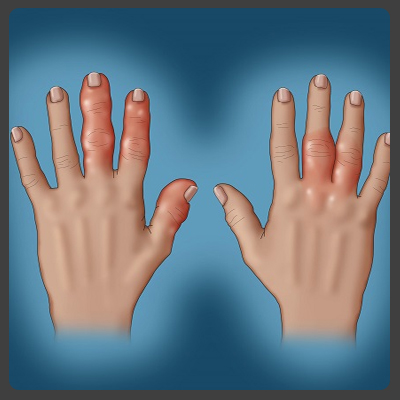

Psoriatic Arthritis is defined as an inflammatory condition of the joints (arthritis) associated with Psoriasis. As in these cases, usually, the rheumatoid factor test is negative, Psoriatic Arthritis is called as seronegative arthritis. Practically, in addition to all the symptoms of Rheumatoid arthritis, Psoriatic Arthritis also has psoriasis.
Psoriatic Arthritis is an autoimmune disease and it affects the ligaments, tendons, fascia, and joints.
Psoriasis is an obstinate skin condition in which red patches of various sizes develop on the skin that is covered with dry, silvery scales.
In psoriasis the skin becomes inflamed and red eruptions appear on the surface of the skin that begins to itch excessively. These areas form thickened areas (plaques) that are covered with silvery scales over the reddened lesions. The skin at the joints may crack.
Psoriasis most often occurs on the elbows, knees, scalp, lower back, palms, and soles of the feet. However, no area of the skin is exempt, including the genital area. The disease may also affect the fingernails and toenails. About 15 percent of people with psoriasis have joint inflammation that produces arthritis symptoms. This condition is called psoriatic arthritis.
When a patient's suffering from psoriasis develops pain, swelling, and inflammation in the joints, it is termed as psoriatic arthritis.Any joint can be affected that may small joints, large joints or the spine .A single or a few joints may get affected
The typical picture is that of a patient suffering from psoriasis from several years suddenly develops acute joint pain and stiffness, thereby announcing the arrival of Psoriatic Arthritis.
Many patients develop arthritis after several years of suffering from psoriasis but a few patients develop arthritis in the early stage of psoriasis.
Patients with extensive psoriasis have more chances of developing psoriatic arthritis. However, mild cases of psoriasis may also present with psoriatic arthritis. Also, it is not a rule that all the cases of psoriasis will have psoriatic arthritis.
Some patients after using steroidal creams for psoriasis may see good relief in the skin, but may subsequently develop arthritis, as the disease goes deeper due to suppression of skin eruptions.
Some patients can develop psoriatic arthritis even with a mild form of skin psoriasis. And a few patients can develop psoriatic arthritis in the absence of psoriasis on the skin. (Seen in around 10 % cases)
In most patients, it is of a mild to moderate severity, but some patients will present with severe pain, restriction of movements, difficulty in walking and disability. In the severe forms, one can see deformity and destruction in the joints.
Flares and remissions usually characterize the course of psoriatic arthritis. Winter, Stress, and infections are likely to aggravate the condition.
Sex : Men and women are affected equally,Men are more likely to be affected by the spondylitic form of psoriatic arthritis and females are more likely to be affected by the rheumatoid form.
Age : Psoriatic arthritis characteristically develops in persons aged 35-55 years, but it can occur in persons of almost any age.
Approximately 40% of patients with psoriasis or psoriatic arthritis have a family history of these disorders in first-degree relatives.
Psoriatic arthritis is associated with an increased frequency of HLA-B7.
Psoriatic arthritis may be triggered by pro-inflammatory cytokines such as Tumor necrosis factor-alpha (TNF-a) and Interleukin IL-1, IL-6, Il-2 and IL-8.
Psoriatic Arthritis is immunologically mediated disease which has some genetic links, which could at times be triggered by long-term emotional stress.
 SYMPTOMS OF PSORIATIC ARTHRITIS
SYMPTOMS OF PSORIATIC ARTHRITISPsoriatic arthritis can also cause inflammation of the spine (spondylitis) and the sacrum, causing pain and stiffness in the low back, buttocks, neck and upper back. Psoriatic spondylitis is more common in men. Around 50 % of these patients have spondylitis and 50 % suffer from sacroiliitis
The back disease is usually slowly progressive with little radiological deterioration as compared with Ankylosing Spondylitis.
Nail changes are commonly seen in psoriatic arthritis. Pitting and ridges are seen in finger and toenails of 80% of patients with psoriatic arthritis.
The diagnosis of Psoriatic Arthritis is mostly clinical and based on the history.
Most patients are likely to be known cases of psoriasis and at a later stage experience involvement of joints.
The of main sign of Psoriatic arthritis is
1.An asymmetrical pattern of digit involvement.
2.Interphalangeal joint involvement is characterized by sausage appearance of the digits (dactylitis).
3.The inflamed joints are swollen and have a purplish- red discoloration.
4.Along with the joint inflammation, psoriasis may be visible on the skin of the joints.
5.The nail changes may be observed in many patients.
Psoriatic arthritis can be treated by Giving Constitutional Homeopathy medicine which helps to control pain, stiffness and swelling by focusing on the underlying root cause of the problem .It offers individuals long term relief and also eliminates the risk of re-occurrence.Some common medicine for psoriatic arthritis depending on symptoms are Kali carbonicum, Rhus Toxicodendron, Natrum Muriaticum, Sulphur, Thuja occidentalis, Sepia, Silica,
RL-35